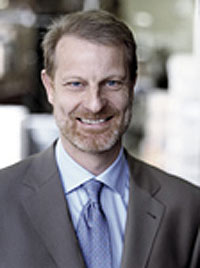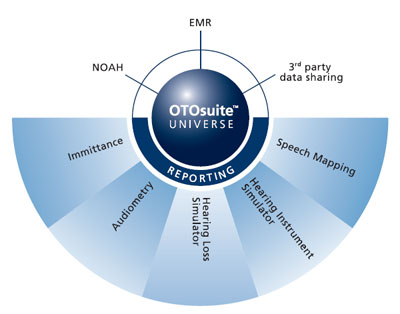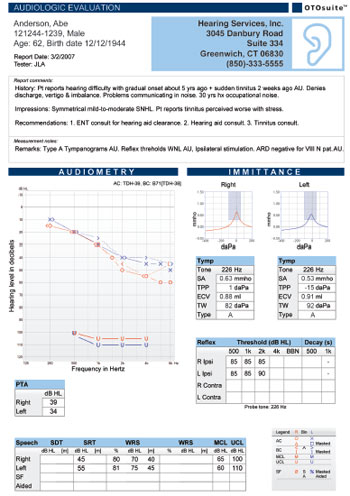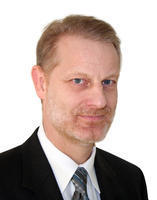Interview with Søren Holst, President, GN Otometrics
Paul Dybala: Hi everyone! This is Paul Dybala with Audiology Online, and today I'm speaking with Søren Holst from GN Otometrics. We are here to discuss the new OTOsuite Universe. Søren, first of all, thank you for having me here.
Søren Holst: Thanks for coming by. I'm excited to talk about our new OTOsuite software.
Søren Holst, President, GN Otometrics
Dybala: The last time we spoke, (See interview posted August, 2006 Archives [link to www.audiologyonline.com/interview/interview_detail.asp?interview_id=402]) we talked a lot about Intelligent Integration and how that's key to a lot of your products. Now it seems that the OTOsuite Universe is really an extension of this. And so if you could, for the readers, just kind of give us just a quick background on what Intelligent Integration is and how that's the basis of what you do.
Holst: Exactly, I'll be happy to do that. The real question to ask is, "Why Intelligent Integration?" Why is it important? I think we need to take the big picture here and see that this industry of hearing-health care faces at least two major challenges. One is that as we go forward, it is highly likely that there will be a shortage of qualified staff to perform audiology services in the United States. We're seeing that the age pyramid is moving upward so more and more elderly people will be looking for services. There's already now a shortage of contract staff, and it will only become increasingly more significant. So this is one challenge.
The other challenge we're facing is that those key customers who will be coming into the clinics in the coming years will be of the baby boomer generation. And as they are used to being critical consumers and getting what they want, they will be a whole new breed of people coming into audiology clinics. They will ask for a high level of service quality involvement and want to take time. They are good customers, but they are demanding customers, too.
If you combine those two factors, there is a shortage of audiology resources to perform what the industry needs. We all want to grow and develop the industry, but we're in a bind here. This is the background for Intelligent Integration. We want to offer the opportunity for the audiologist to ease off the challenges that they are facing by making the system smarter, more intelligent, and help them perform their jobs in the best possible way: taking away the tedious part, the old-fashioned, inefficient part of being an audiologist.
Dybala: Tell us about the OTOsuite Universe.
Holst: The OTOsuite Universe is a platform on which we can integrate equipment and data that you use when you perform audiological evaluations in the clinic. And by integrating things, we make the work easier for the audiologist so there's less paperwork and more time for the patients. And this is what we want: to accommodate their needs. We are doing this by providing a highway that will transport different data around in the system so you don't have to think about it. It will be accessible when you need it. From a practical point of view, it means that you open up your computer, stay within one software universe where you have direct access to your Immittance, Audiometry, Speech Mapping and Simulator tools. You can output the data to whatever format you like: a combined paper report, an electronic file, save it in NOAH or export it to an electronic medical record system.
Dybala: How does it affect the clinic workflow?
Holst: I think this is one of the biggest advances. With OTOsuite the users actually access more than one measurement module from inside the software. You know in NOAH, you can only access one measurement module at a time, by opening up a module, closing it, opening another, closing it. Now with OTOsuite, you basically open one module, perform your complete evaluation, close it, and the data is saved, and you can move on to the next patient. It saves a lot of time. This is also the input that we get back from customers. Again, the whole point of this is to make time for the patients; this is why we say less paperwork and more patients.
Dybala: Does OTOsuite "play well with others"? Does it only work with GN Otometrics equipment?
Holst: If you work through NOAH, OTOsuite allows you to open up data from non-GN Otometrics equipment, if it has already been stored in NOAH. Of course, when you do make a system like this, the integration is smoother with our equipment because it's born into the equipment. The ability to integrate data from other equipment manufacturers is important as you would otherwise have to buy all new equipment at one time and we know that this is not realistic for most clinics.
Dybala: Excellent. Okay, so I could have an audiometer from another manufacturer than GN Otometrics and use that data in OTOsuite?
Integration of diagnostic audiological information into OTOsuite
Holst: That's correct. Essentially you can import data from other manufacturers' equipment and basically use the strengths of OTOsuite to continue working with that data. You can benefit from the fantastic layouts - OTOsuite has big audiograms; it's very nice looking. It's very modern, whereas in elderly software you see small audiograms. These new big screens are looking very nice and give the user instant access to counseling tools such as overlays. You can also use the data for combined reporting.
Dybala:Yes, I was looking at the report that the OTOsuite Universe generates and it is pretty impressive. What's nice too is that you can get the entire report on one sheet. That's a huge time and paper saver.
OTOsuite Universe sample report
Holst: A lot of clinics today are sitting down with two reports, eventually combining them into one, so I think we did a nice job of getting everything onto one page. On top of that the reports are rich in graphics and ready to customize with name and logos.
Dybala: I also understand you can export data from OTOsuite?
Holst: That's correct. There are two steps to that. There's the simple way, where we create an electronic file that you can work on at a later time, and there's the full integration which takes steps to make sure the OTOsuite electronically links into an electronic medical records system. That takes some effort because then you need to do an integration job. But it's absolutely possible, and some of our clients have done it.
Dybala:Well this is very exciting, especially as far as a time saver. Thank you so much for your time, Søren. It's always exciting to hear what's new from GN Otometrics, and I think this software will be a great tool for many practicing audiologists. Was there anything else that you wanted to mention before we wrap things up today?
Holst: I would encourage audiologists to examine their clinic and start preparing themselves for making the transition from where they are into an integrated clinic. Each audiologist needs to prepare themselves for this in the future, because once they are overwhelmed by the work it will be too late. The time is now to decide how to make your clinic into an intelligent and integrated clinic.
Dybala: That's a good point. It was a pleasure talking with you today, and we look forward to great things in the future!
Holst: Of course! Thanks, Paul.
About GN Otometrics:
Copenhagen-based GN Otometrics is the world's leading manufacturer of hearing and balance instruments and software. The company has solutions that range from infant-screening applications and audiologic diagnostics, to balance testing and hearing-aid fitting.
More information about GN Otometrics can be found at www.gnotometrics.com or the GN Otometrics Web Channel on Audiology Online at www.audiologyonline.com/channels/gn_otometrics.asp.


